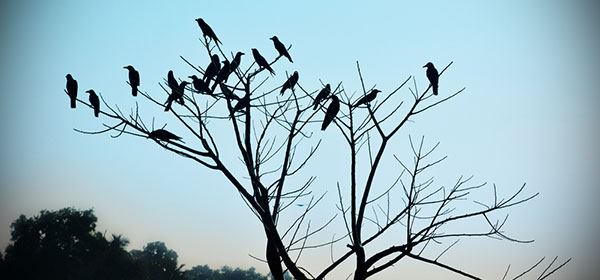From a shrewdness of apes and a murder of crows to a misbelief of painters and a tabernacle of bakers, there sure are some strange collective nouns for animals, trades and professions.
But from where do these collective nouns originate?
Many have their roots in the Middle Ages and have lived on to become stable, although rather curious, mainstays of modern language. But you’ll rarely, if ever, hear them being used.
So, where did a ‘cowardice of dogs’ come from? Or how about a ‘gaggle of geese’? Or my personal favourites, a ‘murder of crows’ and a ‘conspiracy (or unkindness) of ravens’?
Many were first recorded in the 15th-century Books of Courtesy – manuals for noble living that included advice on how not to embarrass oneself in court.
One of the earliest of these books, The Egerton Manuscript, was published around 1450 and contains 106 collective nouns.
Another, from 1486, a treatise on hawking and heraldry called The Book of St Albans, contains some 164 collective nouns covering birds and ‘beasts of the chase’, as well as an array of human professions and trades.
Some of these collective nouns for animals are named for their characteristics, hence ‘a leap of leopards’, ‘a tower of giraffes’ and ‘a busyness of ferrets’, or by how they were used by humans, think ‘a yoke of oxen’ or ‘a burden of mules’.
Some describe their young: ‘a covert of coots’, or ‘a kindle of kittens’, and others how they respond when flushed (hunted) – ‘a sord of mallards’ or ‘a rout of wolves’.
Some of my other favourite collective nouns for animals include a ‘murmuration of starlings’, a ‘chowder/clowder/cluster/glaring of cats’, an ‘army of caterpillars’ (sounds scary!) and a ‘destruction of wildcats’.
Perhaps more fascinating are the names given for trades and types of people. A ‘tabernacle of bakers’, for instance, was named for the shops at the king’s approved markets from which the bread had to be sold – ‘tabernacula’.
Then there’s a ‘stalk of foresters’, named for the role of protecting the forest’s stock (birds, deer and other animals) from poachers and hunting criminals.
A ‘melody of harpers’ may sound obvious – and it is – as is a ‘sentence of judges’. A ‘faith of merchants’ was perhaps ironic as merchants were hardly the most trustworthy folk. Although this may seem insulting to shopkeepers, imagine how poor monks felt, being referred to as ‘an abominable sight of monks’ – monks weren’t particularly revered and respected in the 15th century.
Same goes for a ‘superfluity of nuns’, meant because of the oversaturation of women beyond marriageable age passing through convents.
Other profession/trade collective nouns at the top of my list include a ‘thought of barons’, an ‘entrance of actresses’, a ‘peck of Frenchmen’, a ‘goring of butchers’ and an ‘incredulity of cuckolds’.
Back to answering the question that led me to writing this missive: why a misbelief of painters and a murder of crows?
Well, the painters to whom we are referring are artists, not house decorators, and a good artist could flatter the sitter by making shoulders broader, faces prettier and eyes shinier. In essence, as author of An Unkindness of Ravens: A Book of Collective Nouns Chloe Rhodes writes: “the painter’s job was to conjure misbelief in those who viewed his work; to create the illusion of beauty even where he found none”.
The term ‘murder of crows’ comes from the fact that people think crows aren’t very nice. Farmers consider them pests and they’ve a long history of being associated with fear and death. The truth is, crows are very social, intelligent birds and one of the most caring and smartest animals on earth.
But why ‘a murder’? According to the word-ancestry forum on Live Journal:
“This more poetic term for a flock of crows can be traced back at least to the 15th century, when it was recorded as a ‘murther of crowes’. Murther is a variant of Middle English murthre ‘murder,’ though the ‘th’ sound had begun to be replaced with a d around 1300 CE. There are several theories as to how this particular term came about, but all of them have to do with the supposed behaviour of crows. For instance, crows are scavengers and therefore often seen feeding on rotting bodies of various sorts. Survivors of wars have described how the battlefields were covered in black as crows (and ravens) came down to eat the dead. Another theory hearkens back to old folklore which told of groups of crows essentially holding court over members of their flock that had committed offences. If they decide against the “defendant” crow, then the rest of the flock swoops down on it and kills it. There are legends outside of the Germanic culture that relate to crows being judges over people as well, and how their appearance is an omen of death.”
Do you have a favourite collective noun? Do you know how it came about? Why not share it with our members?
Related articles:
Five words that make Leon cringe
Things you don’t want to hear
Don’t say these words aloud abroad

